Search
- Page Path
- HOME > Search
- [English]
- Effect of the Cross-rolling Process on the Microstructures and Mechanical Properties of 9Cr-1W ODS Steel
- Bu-An Kim, Sanghoon Noh
- J Powder Mater. 2025;32(1):37-42. Published online February 28, 2025
- DOI: https://doi.org/10.4150/jpm.2024.00332
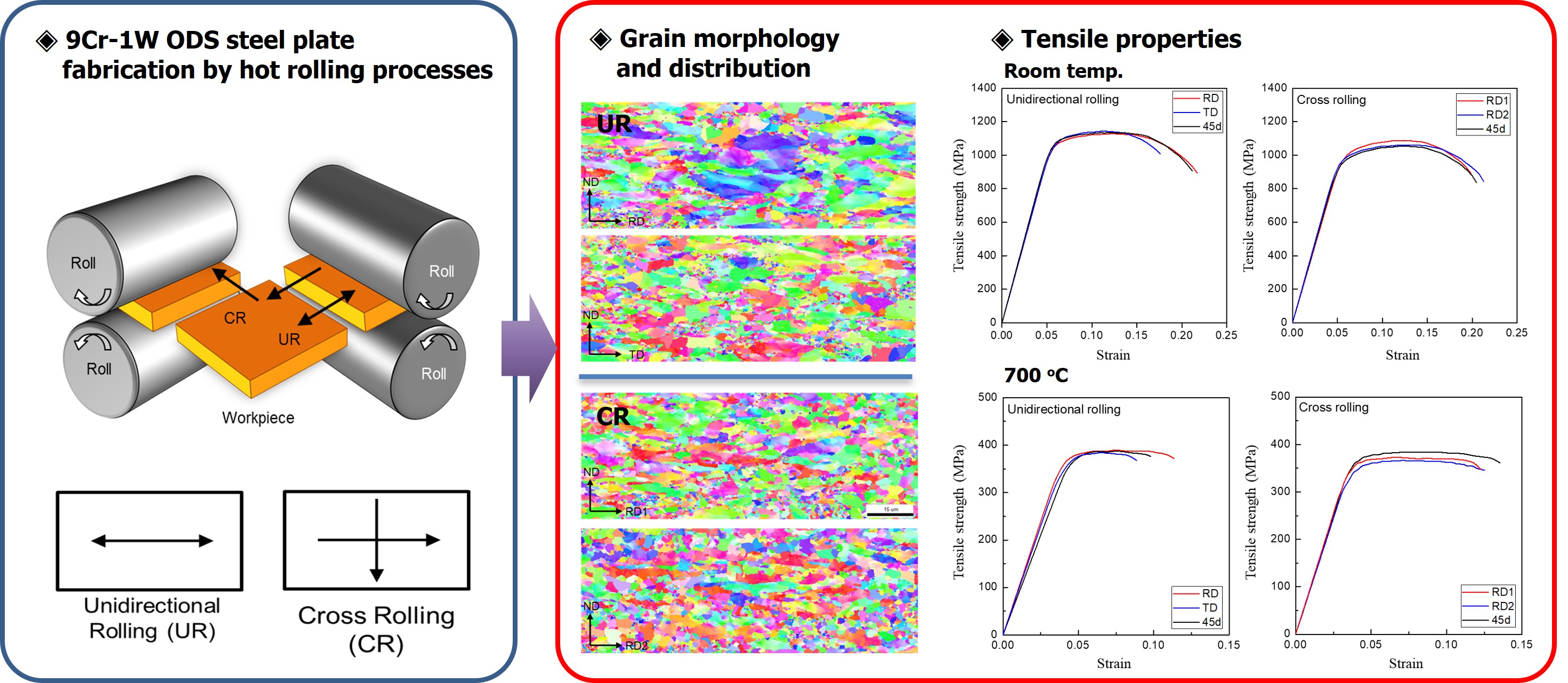
- 722 View
- 23 Download
-
 Abstract
Abstract
 PDF
PDF - This study employed a cross-rolling process to fabricate oxide dispersion strengthened (ODS) steel plates and investigated their microstructures and mechanical properties. The 9Cr-1W ODS ferritic steel was fabricated using mechanical alloying and hot isostatic pressing. The hot cross-rolling process produced thick ODS ferritic steel plates with a well-extended rectangular shape. The working direction greatly affected the grain structure and crystal texture of the ODS ferritic steel. Cross-rolled plates showed fine micro-grains with random crystal orientation, while unidirectionally rolled plates exhibited a strong orientation with larger, elongated grains. Transmission electron microscopy revealed a uniform distribution of nano-oxide particles in both rolling methods, with no major differences. Tensile tests of the ODS ferritic steel plates showed that the unidirectional rolled plates had anisotropic elongation, while cross-rolled plates exhibited isotropic behavior with uniform elongation. Cross-rolling produced finer, more uniform grains, reducing anisotropy and improving mechanical properties, making it ideal for manufacturing wide ODS steel components.
- [Korean]
- A Study on the Roll Manufacturing Technology Applying Powder Flame Spray Coating Technology of Ni-Based Alloy Powder
- Ji Woong Park, Soon Kook Kim, Gye Bum Ban
- J Powder Mater. 2022;29(2):123-131. Published online April 1, 2022
- DOI: https://doi.org/10.4150/KPMI.2022.29.2.123

- 866 View
- 8 Download
- 1 Citations
-
 Abstract
Abstract
 PDF
PDF The purpose of this study is to improve the mechanical properties and develop manufacturing technology through self-soluble alloy powder flame spray coating on the surface of a run-out table roller for hot rolling. The roller surface of the run-out table should maintain high hardness at high temperatures and possess high wear, corrosion, and heat resistances. In addition, sufficient bonding strength between the thermal spray coating layer and base material, which would prevent the peel-off of the coating layer, is also an important factor. In this study, the most suitable powder and process for roll manufacturing technology are determined through the initial selection of commercial alloy powder for roll manufacturing, hardness, component analysis, and bond strength analysis of the powder and thermal spray coating layer according to the powder.
-
Citations
Citations to this article as recorded by- Influence of rare earth oxides on microstructure and mechanical properties of nickel-based superalloys fabricated by high energy beam processing: A review
Lianjie Bi, Hua Yan, Peilei Zhang, Haichuan Shi, Zhiyuan Li, Ruidi Li
Journal of Rare Earths.2024; 42(9): 1629. CrossRef
- Influence of rare earth oxides on microstructure and mechanical properties of nickel-based superalloys fabricated by high energy beam processing: A review
- [Korean]
- Controlling the Heat Generation Capability of Iron Oxide-Base Nanoparticles
- Jin-sil Choi
- J Korean Powder Metall Inst. 2021;28(6):518-526. Published online December 1, 2021
- DOI: https://doi.org/10.4150/KPMI.2021.28.6.518

- 513 View
- 5 Download
-
 Abstract
Abstract
 PDF
PDF This review summarizes the recent progress in iron-oxide-based heat generators. Cancer treatment using magnetic nanoparticles as a heat generator, termed magnetic fluid hyperthermia, is a promising noninvasive approach that has gained significant interest. Most previous studies on improving the hyperthermia effect have focused on the construction of dopant-containing iron oxides. However, their applications in a clinical application can be limited due to extra dopants, and pure iron oxide is the only inorganic material approved by the Food and Drug Administration (FDA). Several factors that influence the heat generation capability of iron-oxide-based nanoparticles are summarized by reviewing recent studies on hyperthermia agents. Thus, our paper will provide the guideline for developing pure iron oxide-based heat generators with high heat dissipation capabilities.
- [Korean]
- Current Status of Titanium Smelting Technology for Powder Metallurgy
- Ho-Sang Sohn
- J Korean Powder Metall Inst. 2021;28(2):164-172. Published online April 1, 2021
- DOI: https://doi.org/10.4150/KPMI.2021.28.2.164
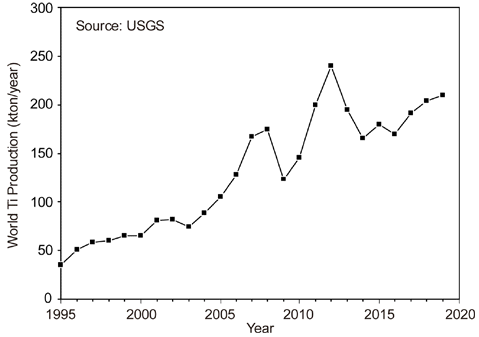
- 619 View
- 8 Download
- 1 Citations
-
 Abstract
Abstract
 PDF
PDF Titanium is the ninth most abundant element in the Earth’s crust and is the fourth most abundant structural metal after aluminum, iron, and magnesium. It exhibits a higher specific strength than steel along with an excellent corrosion resistance, highlighting the promising potential of titanium as a structural metal. However, titanium is difficult to extract from its ore and is classified as a rare metal, despite its abundance. Therefore, the production of titanium is exceedingly low compared to that of common metals. Titanium is conventionally produced as a sponge by the Kroll process. For powder metallurgy (PM), hydrogenation-dehydrogenation (HDH) of the titanium sponge or gas atomization of the titanium bulk is required. Therefore, numerous studies have been conducted on smelting, which replaces the Kroll process and produces powder that can be used directly for PM. In this review, the Kroll process and new smelting technologies of titanium for PM, such as metallothermic, electrolytic, and hydrogen reduction of TiCl4 and TiO2 are discussed.
-
Citations
Citations to this article as recorded by- Enhancing corrosion resistance of Ti-based amorphous alloy powders via misch metal addition
Yeon Joo Lee, Hyokyung Sung, Jae Bok Seol, Kisub Cho, Hwi Jun Kim, Hyunjoo Choi
Powder Metallurgy.2025; 68(3): 230. CrossRef
- Enhancing corrosion resistance of Ti-based amorphous alloy powders via misch metal addition
- [English]
- Microstructure and Soft Magnetic Properties of Fe-6.5 wt.%Si Sheets Fabricated by Powder Hot Rolling
- Myung Shin Kim, Do Hun Kwon, Won Sik Hong, Hwi Jun Kim
- J Korean Powder Metall Inst. 2017;24(2):122-127. Published online April 1, 2017
- DOI: https://doi.org/10.4150/KPMI.2017.24.2.122
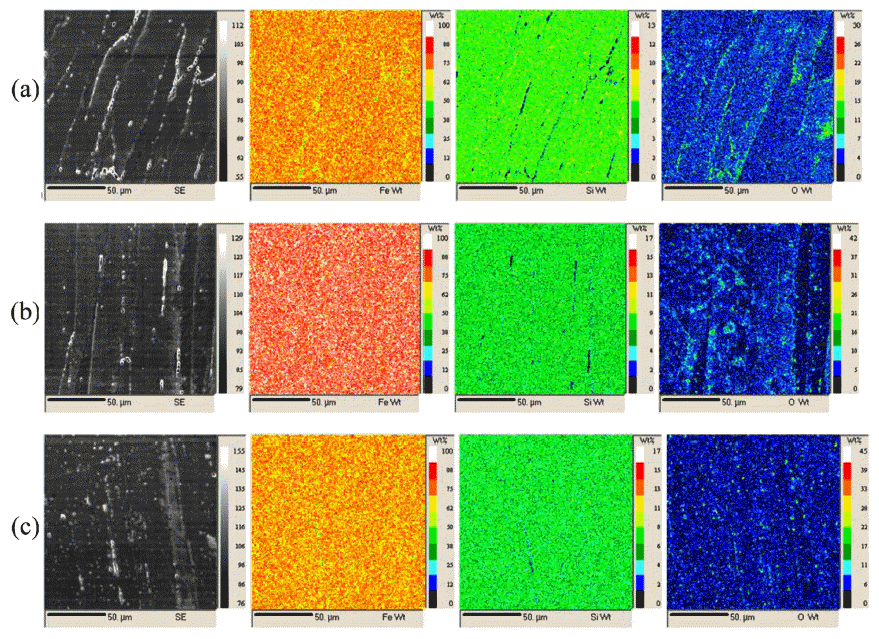
- 623 View
- 8 Download
-
 Abstract
Abstract
 PDF
PDF Fe-6.5 wt.% Si alloys are widely known to have excellent soft magnetic properties such as high magnetic flux density, low coercivity, and low core loss at high frequency. In this work, disc-shaped preforms are prepared by spark plasma sintering at 1223 K after inert gas atomization of Fe-6.5 wt.% Si powders. Fe-6.5 wt.% Si sheets are rolled by a powder hot-rolling process without cracking, and their microstructure and soft magnetic properties are investigated. The microstructure and magnetic properties (saturation magnetization and core loss) of the hot-rolled Fe-6.5 wt.% Si sheets are examined by scanning electron microscopy, electron backscatter diffraction, vibration sample magnetometry, and AC
B–H analysis. The Fe-6.5 wt.% Si sheet rolled at a total reduction ratio of 80% exhibits good soft magnetic properties such as a saturation magnetization of 1.74 T and core loss (W5/1000) of 30.7 W/kg. This result is caused by an increase in the electrical resistivity resulting from an increased particle boundary density and the oxide layers between the primary particle boundaries.
- [Korean]
- Microstructure and Mechanical Properties of CNT/Al Composite Fabricated by a Powder-in-Sheath Rolling Method utilizing Copper Tube as a Sheath
- Seong-Hee Lee
- J Korean Powder Metall Inst. 2014;21(5):343-348. Published online October 1, 2014
- DOI: https://doi.org/10.4150/KPMI.2014.21.5.343
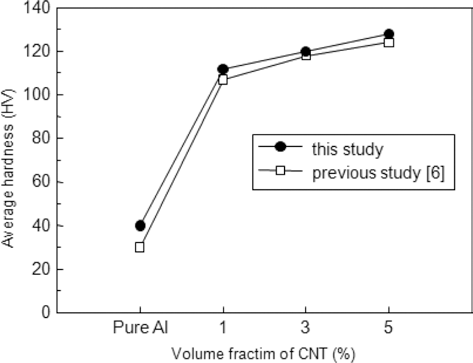
- 535 View
- 0 Download
-
 Abstract
Abstract
 PDF
PDF A powder-in-sheath rolling (PSR) process utilizing a copper alloy tube was applied to a fabrication of a multi-walled carbon nanotube (CNT) reinforced aluminum matrix composite. A copper tube with an outer diameter of 30 mm and a wall thickness of 2 mm was used as a sheath material. A mixture of pure aluminum powders and CNTs with the volume contents of 1, 3, 5 vol% was filled in the tube by tap filling and then processed to 93.3% height reduction by a rolling mill. The relative density of the CNT/Al composite fabricated by the PSR decreased slightly with increasing of CNTs content, but showed high value more than 98%. The average hardness of the 5%CNT/Al composite increased more than 3 times, compared to that of unreinforced pure Al powder compaction. The hardness of the CNT/Al composites was some higher than that of the composites fabricated by PSR using SUS304 tube. Therefore, it is concluded that the type of tube affects largely on the mechanical properties of the CNT/Al composites in the PSR process.
- [Korean]
- Fabrication and Evaluation of Carbon Nanotube Reinforced Al Matrix Composite by a Powder-in-sheath Rolling Method
- Seong-Hee Lee, Dongmin Hong
- J Korean Powder Metall Inst. 2014;21(1):50-54. Published online February 1, 2014
- DOI: https://doi.org/10.4150/KPMI.2014.21.1.50
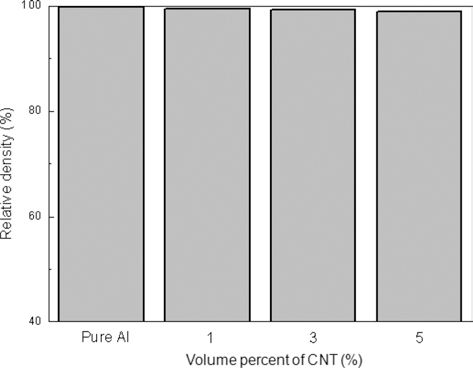
- 668 View
- 0 Download
- 5 Citations
-
 Abstract
Abstract
 PDF
PDF A powder-in-sheath rolling method was applied to a fabrication of a carbon nano tube (CNT) reinforced aluminum composite. A STS304 tube with an outer diameter of 34 mm and a wall thickness of 2 mm was used as a sheath material. A mixture of pure aluminum powders and CNTs with the volume contents of 1, 3, 5 vol was filled in the tube by tap filling and then processed to 73.5% height reduction by a rolling mill. The relative density of the CNT/ Al composite fabricated by the powder-in-sheath rolling decreased slightly with increasing of CNTs content, but exhibited high value more than 98. The grain size of the aluminum matrix was largely decreased with addition of CNTs; it decreased from 24 μm to 0.9 μm by the addition of only 1 volCNT. The average hardness of the composites increased by approximately 3 times with the addition of CNTs, comparing to that of unreinforced pure aluminum. It is concluded that the powder-in-sheath rolling method is an effective process for fabrication of CNT reinforced Al matrix composites.
-
Citations
Citations to this article as recorded by- Torsion Property of the Structure Bonded Aluminum Foam Due to Impact
G.W. Hwang, J.U. Cho
Archives of Metallurgy and Materials.2017; 62(2): 1353. CrossRef - A Fatigue Fracture Study on TDCB Aluminum Foam Specimen of Type Mode III Bonded with Adhesive
J.H. Lee, J.U. Cho
Archives of Metallurgy and Materials.2017; 62(2): 1359. CrossRef - Experimental Study On Fracture Property Of Double Cantilever Beam Specimen With Aluminum Foam
Y.C. Kim, H.K. Choi, J.U. Cho
Archives of Metallurgy and Materials.2015; 60(2): 1151. CrossRef - Experimental Study On Fracture Property Of Tapered Double Cantilever Beam Specimen With Aluminum Foam
Y.C. Kim, S.S. Kim, J.U. Cho
Archives of Metallurgy and Materials.2015; 60(2): 1459. CrossRef - Microstructure and Mechanical Properties of CNT/Al Composite Fabricated by a Powder-in-Sheath Rolling Method utilizing Copper Tube as a Sheath
Seong-Hee Lee
Journal of Korean Powder Metallurgy Institute.2014; 21(5): 343. CrossRef
- Torsion Property of the Structure Bonded Aluminum Foam Due to Impact
TOP
 KPMI
KPMI


 First
First Prev
Prev


